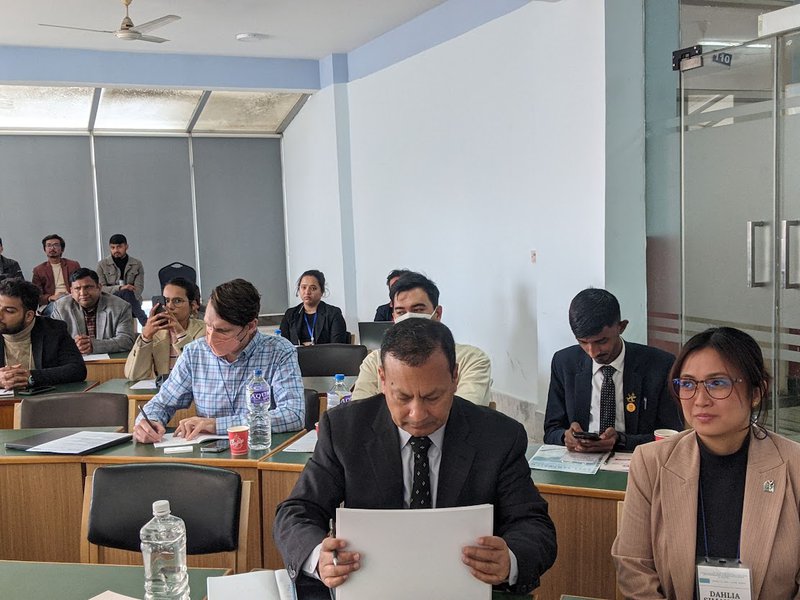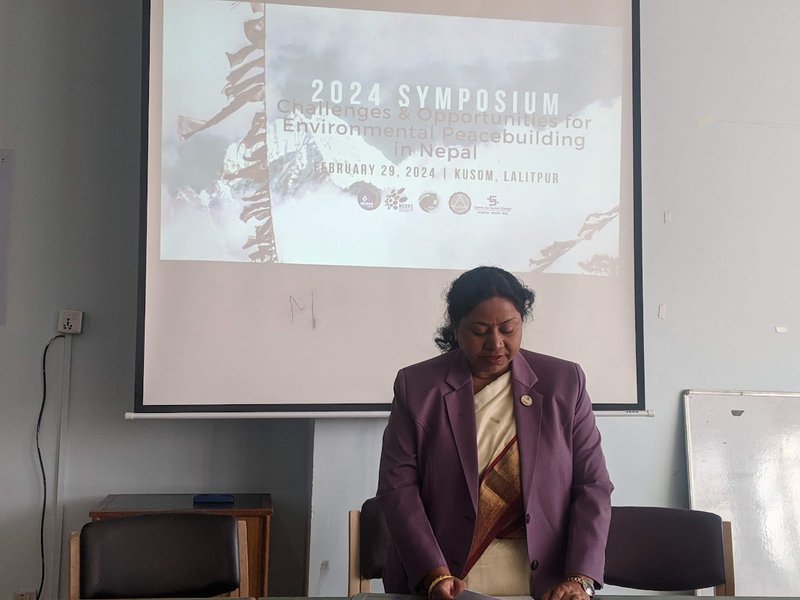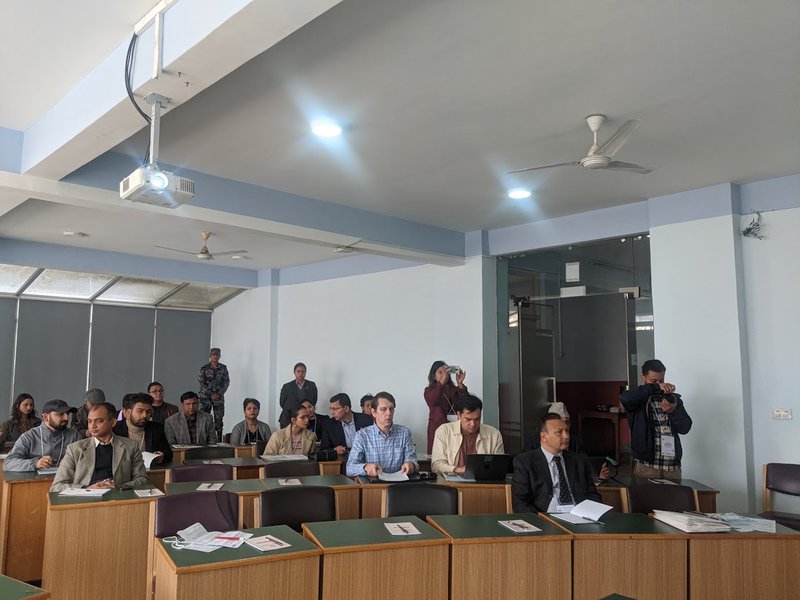

A delegation led by Koshi Province Chief Minister Kedar Karki completed a 100-kilometer walk in elephant-affected areas to promote wildlife protection and tourism.
Starting from Prasad Gauda in Mechinagar Municipality Ward No. 4, which is located on the border between Nepal and India, CM Karki began his journey. For generations, Indian and Nepalese elephants have been free ranging across the Bahundangi border, spanning 275 kilometers across the municipalities of Morang, Sunsari, and Udayapur in the districts of Jhapa and Ilam.
Similarly, ward 19 of Pokhara Metropolis issued an order to chop trees in order to manage monkeys. The province administration, which is heavily impacted by monkeys, has put in place a policy to regulate them.
There is an increasing amount of conflict in Chitwan, Parsa, Bardia, and other national parks between the rhino, tigers, and other wild creatures and humans.
Conflicts between upper and lower riparians in various urban and rural areas of Nepal are becoming more intense as springs run out and water demand rises.

The Network for Education and Research on Peace and Sustainability (NERPS), Hiroshima University, Hiroshima University Scholars Alumni Nepal (HiUSAN), Kathmandu University School of Education, and Center for Social Change collaborated to organize a Symposium for Environmental Peacebuilding in Nepal at a time when environmental-related conflicts are on the rise in the country.
Scholars, peace practitioners, academics, specialists, and students engaged in discourse on a range of themes, including human conflicts involving wildlife, water-related conflicts, and climate-related conflicts. They also talked about several strategies and actions for handling environmental problems. The program was conducted by Parmita Shrestha.
What Is Environmental Peacebuilding?
Even though it's still relatively young, environmental peace building is developing quickly. The spectrum of topics it covers in handling conflict still has a lot of complexity that one needs to be aware of.
A collection of strategies and actions for handling environmental problems in order to aid in peace building and conflict resolution is known as environmental peace building. In her introductory remarks, Associate Professor Dahila Simangan of Hiroshima University stated, "There are immense opportunities for the study, particularly for a country like Nepal where environmental stresses contribute to insecurity and instability."
"This symposium brings together experts in sustainability and peace to discuss the opportunities and challenges for advancing environmental peace building knowledge and practices in Nepal and beyond, building on the success of the successful symposium held there last year."

Mohan Das Manandhar, the chairman of the Niti Foundation, gave the keynote talk at the event, which was opened by Pramila Kumari, the state minister of education, science, and technology. He discussed the various partnerships that may be used to improve environmental peacebuilding in Nepal.
The importance of the 1992 UN Conference on Environment and Development premise was underlined by Manandhar. "I'm happy to report that Nepal has demonstrated innovative approaches to environmental peacebuilding, setting an example for international societies with community-managed protected areas, community-patrolled wildlife areas, and community-managed forests."There are obstacles in the way of achieving environmental justice, especially when there are power disparities and the legal system favors the wealthy and powerful.
According to Manandhar, "accounting for fundamental rights like life, liberty, political participation, compensation, and fairness is necessary to achieve environmental justice."
Dr. Manohara Khadka, the country director of the International Water Management Institute, gave a research presentation on the topic of Natural Resources Governance Conflicts in Federal Nepal: Opportunities for Peacebuilding.
Dr. Khadka emphasized in her talk the disagreements between government agencies about community and water management. There are 225 billion cubic meters of water in Nepal, but only 1.6 have been used for economically significant physical hydropower, 33% of the 2.50 million hectors of irrigable land are under year-round irrigation, and 19% of people have access to carefully managed water.

She claimed that the water held the key to restoring livelihoods, equality, and peace. According to her, disputes over water are linked to issues of management and access.
Dr. Khadka outlined the difficulties and possibilities in managing water resources and explained how water is a potential cause of conflict and Peacebuilding.
"Loss of freshwater biodiversity and degradation of wetland ecosystems as a result of the effects of water infrastructure, such as hydropower and water extraction," stated Dr. Khadka. Dr. Khadka emphasized on vague and confusing government regulations as well as other variables in her presentation on water infrastructures and disputes.
Environmental conflict is becoming more prevalent in Nepal, as noted by Shradha Khadka of the Center for Social Change in her presentation on challenges to peace and environmental sustainability in Nepal.
According to Khadka, out of 100 violent conflict incidents, 85% involved animal attacks, such as fights involving elephants and other wild animals and people. Of this, 7% is due to unlawful hunting and poaching, while 5% is related to attacks and assaults. There is hardly any political violence—roughly 2%.
According to media reports, Khadka's address highlighted Nepal's pressing environmental challenges and their need for resolution.
Natural resource disputes have been at the center of at least 40% of state-level conflicts worldwide since 1946. Conflicts involving natural resources are more likely to recur and do so twice as quickly.
For a long time, environmental provisions were uncommon in peace agreements. However, this has gradually changed, and since 2005, environmental issues have been included in every significant peace agreement. Depending on the situation, the emphasis has alternated between livelihoods and the harmful effects of war or on causes like unequal land distribution.

According to Professor Vishnu Pandey of Tribhuwan University's Institute of Engineering, environmental peacebuilding aims to eliminate the environmental aspects of conflict and comprehend how conflict and the environment are related.
According to him, the goal of environmental peace building is to foster constructive peace by highlighting the use of common environmental interests to unite people in order to exchange knowledge and take action in that interest.
According to Professor Pandey, cooperation is typically present, but there has also been intentional cooperation in the area of peace parks. For instance, the creation of the Cordillera del Condor Park, which encompasses the formerly disputed region, was one of the terms of the peace accord that ended a protracted border battle between Ecuador and Peru.
Dr. Prabin Manandhar, the country director of Helvetas-Nepal, moderated Dr. Parbat Dhungel, Associate Professor, Kathmandu University School of Education. He emphasized the opportunities and problems that come with managing natural resources. He stated that fair resource allocation is essential to preventing any significant disputes, giving the community-managed drinking water programs as an example.
Additionally, he claimed that unequal land allocation was a major cause of violence in many terai areas, including those with national parks. According to him, environmental peace building uses land reform initiatives to avert a return to hostilities.
Human-wildlife conflicts in Nepal are becoming more intense due to activities caused by humans, as noted by Sanjivani Yonjan of Wildlife Conservation Nepal. She asserted that humans and animals must coexist in harmony. When it comes to conflicts between humans and animals, the situation is now quite complicated throughout the majority of Nepal.
Resources used in conflicts have fueled them; environmental peace building can create alternate means of subsistence and guarantee control over the money sources.
Environmental peace building is complicated, though. The fact that environmental peace building is a meta-framework accounts for a large portion of its complexity.
A paper titled "Navigating the Stormy C's: Clarity, Appropriate channels, and Co-authorship" was presented by Dr. Joshua Fisher of Columbia University and NERPS of Hiroshima University in the first parallel session on skill training for students and early-carrier researchers. Similarly, a paper titled Academic Productivity Hacks: From To-do to Ta-Da was presented by Dr. John Lee Candelaria of NERPS at Hiroshima University.
During the study session, the following individuals shared their perspectives on environmental peace building in Nepal: Dr. Prakash Bhattarai, CSC; Dr. Dahalia Simangan, NERPS, Hiroshima University; Shradha Khadka, CSC; Sumita Puri, CSC; Rihan Shrestha, KUSOED; and Riyaz Karki, Hiroshima University.
According to Dr. Dahalia Simangan, environmental peace building incorporates a broad range of topics and approaches, including, but not limited to, climate security, sustainable livelihoods, resource conflict, conflict-sensitive programming, and environmental cooperation. Though it's unclear how it all comes together, she claimed that each theme has its own theories of transformation.
She added that the scale, variety of actors, and range of specialties all contribute to the complexity. She emphasized that people have been pursuing environmental peace building as a result of inventiveness and necessity. They work in the military, development, peacekeeping, and environmental fields, among others.
Speakers at this week's Second International Conference on Environmental Peace building said, "We have a lot of work ahead of us, but as the hundreds of attendees illustrated, we are well on our way."

Others emphasized that they hold degrees in a plethora of subjects, including gender studies, hydrology, forestry, political science, anthropology, geography, and law. They operate in social conflict, latent conflict, recent conflict, present conflict, and fragility scenarios.
Dr. Ranjan Prakash Shrestha, president of Hiroshima University HiUSAN, stated in his closing remarks that while the symposium contributes to a greater understanding of the risks, there is still a dearth of knowledge regarding the solutions. We are aware of the dangers posed by the resource curse after hearing the opinions of eminent academics and professionals, but there are uneven approaches to mitigating it.
Additionally, he stated that while it is helpful to comprehend how unequal land distribution may and frequently does fuel conflict, few examples of land reform have been genuinely successful.
The relationship between environmental peace building and people's lives is fascinating. We now know enough to recognize the importance and complexity of environmental peace building. But additional information is needed. We must ascertain what functions in what situations. We must understand the connections between the various dynamics and their implications, added Shrestha.

We must comprehend the similarities and differences between environmental peace building during military conflict and peace building during social conflict. Knowing if we are on track and when we need to adjust course.”
First, addressing environmental challenges in post-conflict environments has become a prominent concern with the growing number of peace building interventions by the international community and nongovernmental organizations (NGOs).
This is particularly true given that modern warfare seriously harms the environment and that land and water are essential for reestablishing livelihoods. Second, the security ramifications of climate change are causing concern for a growing number of academics and decision-makers, with the effect of climate change on violent conflict being a particularly hot topic.
Environmental conflict narratives that are determinist and securitizing can be countered by a parallel analytical perspective that emphasizes environmental cooperation and its potential to enhance peace.
In general, environmental peace building refers to initiatives aimed at fostering more harmonious relationships by integrating environmental issue management into conflict avoidance, resolution, and recovery processes.

Even though Nepal was able to resolve a violent political conflict through its own peace process in the last eighteen months, there has been a notable increase in interest in environmental peace building, in part because environmental issues are becoming more pressing and the globe is becoming less peaceful. These advancements have led to a sharp increase in the body of research on environmental peacebuilding.

Keshab Poudel
Poudel is the editor of New Spotlight Magazine.
- HELVETAS NEPAL’S RIVERBED FARMING: Shift From Overseas To Local Farming
- Jul 26, 2024
- POLITICAL SCENARIO : K.P. Sharma Oli's Resurgence
- Jul 21, 2024
- UNDP/MinErgy: An Inventive Approach To Clean Brick Kiln
- Jul 19, 2024
- HELVETAS NEPAL: Nutrition Through Riverbed Farming
- Jul 18, 2024
- NOU Opens To All: Dr. Shilu Manandhar Bajracharya, Vice Chancellor
- Jul 15, 2024
















